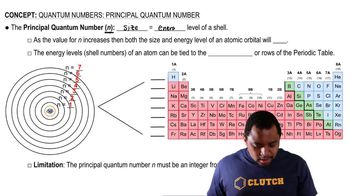Here are the essential concepts you must grasp in order to answer the question correctly.
Ionization Energy
Ionization energy is the energy required to remove an electron from an atom in its gaseous state. It generally increases across a period due to increasing nuclear charge, which attracts electrons more strongly, and decreases down a group as electrons are added to higher energy levels, which are further from the nucleus.
Recommended video:
Effective Nuclear Charge (Zeff)
Effective nuclear charge (Zeff) is the net positive charge experienced by an electron in a multi-electron atom. It accounts for the shielding effect of inner electrons, meaning that outer electrons feel a reduced attraction to the nucleus. A higher Zeff leads to a stronger attraction between the nucleus and the outer electrons, resulting in higher ionization energy.
Recommended video:
Principal Quantum Number (n)
The principal quantum number (n) indicates the main energy level occupied by an electron in an atom. As n increases, the electron is located further from the nucleus, which generally results in a weaker attraction to the nucleus and lower ionization energy. Thus, electrons in higher n levels are easier to remove compared to those in lower n levels.
Recommended video:

 Verified step by step guidance
Verified step by step guidance

